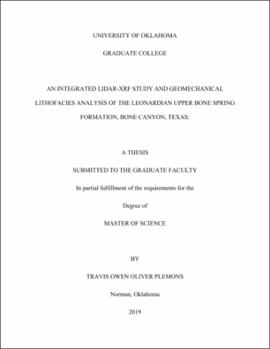| dc.contributor.advisor | Pigott, John | |
| dc.contributor.author | Plemons, Travis | |
| dc.date.accessioned | 2019-05-09T20:00:00Z | |
| dc.date.available | 2019-05-09T20:00:00Z | |
| dc.date.issued | 2019-05 | |
| dc.identifier.uri | https://hdl.handle.net/11244/319664 | |
| dc.description.abstract | The purpose of this study is to constrain geomechanical parameters effecting hydraulic stimulation networks within the upper Bone Spring formation, through the collection and examination of outcrop data. Data utilized in this study was gathered from the Bone Canyon, located within the western escarpment of the Guadalupe Mountains, Texas. LiDAR scans were conducted at 13 stations within the Bone Canyon outcrop, utilizing 110 Schmidt Hammer measurements and 140 XRF recordings in order to form a lithofacies-constrained geomechanical model. LiDAR point cloud data was also utilized to characterize fracture orientations, fracture density, and average bedding thickness within the Bone Spring outcrop. Inferences of geomechanical properties are assigned to 5 facies packages identified within the upper Bone Spring formation. Outcrop descriptions and petrographic analysis were performed with the purpose of forming a heightened interpretation of stratigraphic intervals present within the Bone Canyon outcrop.
The findings of this study suggest that: 1) Primary fracture orientations within the upper Bone Spring include a NW-SE trending primary set, consisting of a hexagonal NE-SW strike secondary set present within an interbedded chert-mudstone package identified in the canyon. Primary fracture orientations alternate into a nodular chert-mudstone package positioned stratigraphically above, with NE-SW orientations dominant. 2) The highest fracture densities are observed within the nodular chert-mudstone package and an interpreted detritally-sourced channel within the Cutoff Formation. Fracture densities also show an inverse logarithmic correlation with bedding thickness 3) Anoxic/Euxinic proxies show substantial positive correlations with Schmidt Hammer-corrected rebound hardness values within the nodular chert-mudstone package (Carbonate A) and interbedded chert-mudstone package (Carbonate B). Positive correlations were also observed between dolomite/quartz volume and rebound values. 4) Fine-scale high/low strength couplets have been inferred from data observations collected within a biogenic silica identified in the 1st Bone Spring Carbonate. | en_US |
| dc.language | en_US | en_US |
| dc.subject | Geology | en_US |
| dc.subject | Geomechanics | en_US |
| dc.subject | Stratigraphy | en_US |
| dc.title | An Integrated LiDAR-XRF Study and Geomechanical Lithofacies Analysis of the Leonardian Upper Bone Spring Formation, Bone Canyon, Texas | en_US |
| dc.contributor.committeeMember | Carpenter, Brett | |
| dc.contributor.committeeMember | Pigott, Kulwadee | |
| dc.date.manuscript | 2019-05 | |
| dc.thesis.degree | Master of Science | en_US |
| ou.group | Mewbourne College of Earth and Energy::Conoco Phillips School of Geology and Geophysics | en_US |
